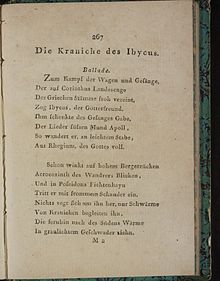The cranes of Ibycus
Die Kraniche des Ibykus is a ballad by Friedrich Schiller from the year 1797. It was first published in Schiller's Musen-Almanach for the year 1798 .
content
action
The ballad deals with the legendary murder of the poet Ibykos , who is murdered on the way to the Isthmian Games by robbers who later unmask themselves. The ballad begins with the verses:
To the battle of chariots and chants,
Who happily
united the tribes of the Greeks on Corinthus Strait ,
Drew Ibykus, the godly friend.
The Greek poet Ibykus is murdered on the way to the Isthmic Games off Corinth , only a crane train is witness. But by virtue of the choir singing of the Erinyes in a tragedy during the Isthmia , one of the perpetrators involuntarily calls out as the cranes move across the theater that is open to the sky: “Look there! Look there, Timothy, The Cranes of Ibycus! "And the whole audience recognizes the murderers at once:
They are torn and dragged before the judge,
the scene becomes a tribunal,
and the villains confess, struck
by the ray of vengeance.
analysis
As a ballad, the poem contains elements of all three basic forms of the poetic:
- Lyric elements
- Form: 23 stanzas of 8 verses each: 2 pair and 2 cross rhymes.
- Meter: 4-way iambus
- Content: Song of the Erinyes
- Epic elements
- Epic simple past (parts of 1st stanza)
- Historical present tense
- Narrated plot
- Narrator: omniscient narrator
- Dramatic elements
- Content: Appearance of the Erinyes, the scene becomes a tribunal
- Verbatim speech
- Dramatic present tense (also historical present tense)
Schiller makes the effect of the arts in the socio-political area the topic. He sees the theater as a “moral institution” that can have great educational effects. In this ballad he shows the effect of a performance in the Greek theater: ... Mind-numbing, heart-bewitching | Does the Erinyes chant sound, | It resounds, consuming the listener's mark ... The result of this performance is that one of the perpetrators exposes himself and his accomplices so that earthly justice can take action.
Trivia
"And I still consider the most beautiful German ballad to be the one that tells of Ibykus, the friend of the gods."
literature
- Klaus Köhnke: 'Des fate's dark balls': To Schiller's ballad 'Die Kraniche des Ibykus' . In: Journal for German Philology 108: 4, 1989, pp. 481–495.
- Karl Moritz: German ballads. Analyzes for German lessons . Schöningh, Paderborn 1972. ISBN 3-506-72814-8 .
- Heinz Politzer : Scene and Tribunal: On the dramaturgy of a Schiller ballad. In: Neue Rundschau 78, 1967, pp. 454–468.
- Helmuth Rehder: 'The Cranes of Ibykus': The Genesis of a Poem . In: Journal of English and Germanic Philology 48, 1949, pp. 543-567.
- Wulf Segebrecht : Natural Phenomenon and Art Idea. Goethe and Schiller in their collaboration as ballad poets, illustrated using the example of the Ibycus cranes. In: Karl Richter and Jörg Schönert (eds.): Classic and Modern: The Weimar Classic as a historical event and challenge in the cultural-historical process . Schönert, Stuttgart 1983, pp. 194-206.
- Benno von Wiese : Schiller's ballad 'Die Kraniche des Ibykus' and its connection with Schiller's view of the theater. In: German Quarterly 29: 3, 1956, pp. 119-123.
- Friedrich-Wilhelm Wentzlaff-Eggebert : Schiller: 'The cranes of Ibycus' . In: Walther Müller-Seidel and Albrecht Weber (eds.): Paths to the Poem , Volume II: Interpretations of Ballads . Schnell and Steiner, Munich and Zurich 1963, pp. 213–228.
Web links
Individual evidence
- ↑ Marcel Reich-Ranicki: The Heine case. dtv, Munich 2000, p. 79

